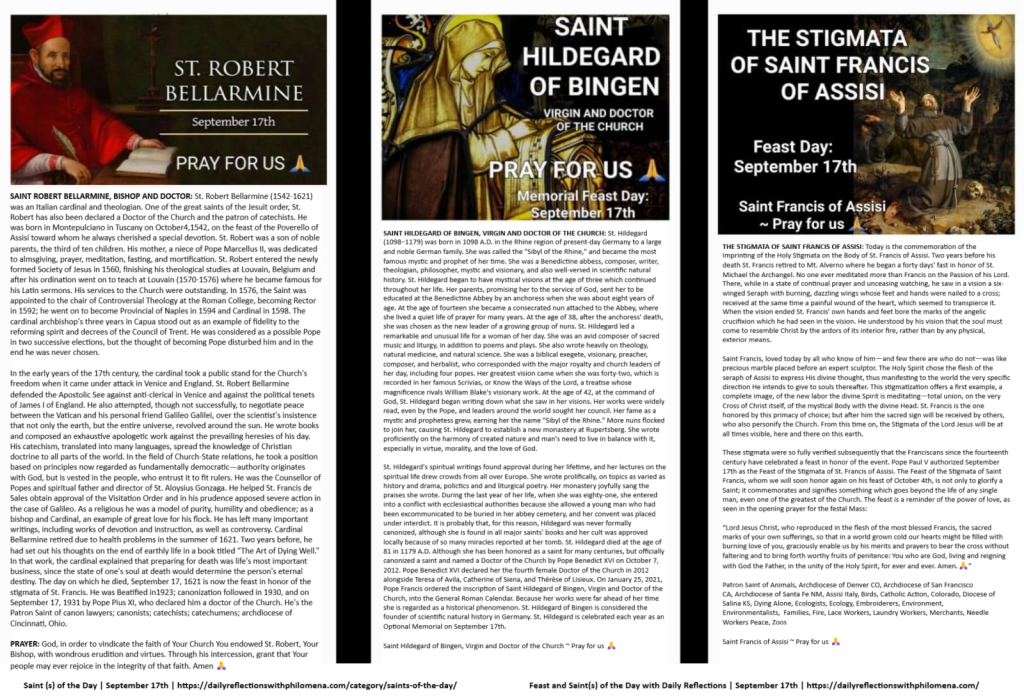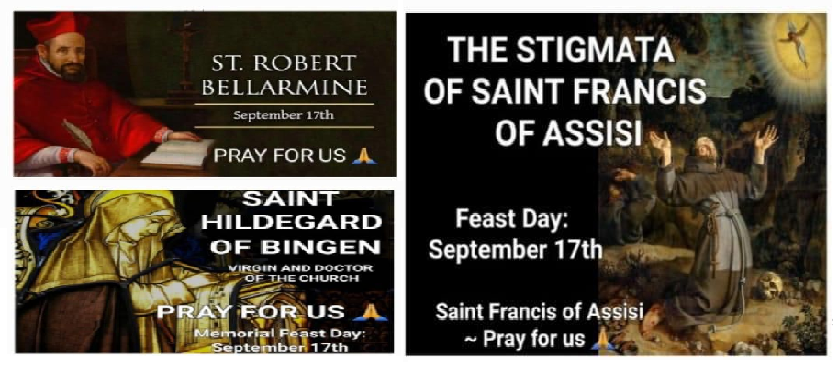
MEMORIAL OF SAINT ROBERT BELLARMINE, BISHOP AND DOCTOR; SAINT HILDEGARD OF BINGEN, VIRGIN AND DOCTOR OF THE CHURCH AND THE STIGMATA OF SAINT FRANCIS OF ASSISI ~ FEAST DAY: SEPTEMBER 17TH: Today, we celebrate Saint Robert Bellarmine, Bishop and Doctor; Saint Hildegard of Bingen, Virgin and Doctor of the Church and the Stigmata of St. Francis of Assisi. Through the intercession of our Blessed Mother Mary and the Saints on this feast day, we humbly pray for the sick and dying, especially those who are mentally and physically ill, and those suffering from cancers and other terminal diseases. We pray for the souls in Purgatory and the repose of the souls of the faithful departed. We pray for the poor and needy, for all widows and widowers, for peace, love, and unity in our marriages, our families and our world. And we continue to pray for our Holy Father, the Bishops, the Clergy, for vocations to the priesthood and religious life, for the Church, for persecuted christians, for the conversion of sinners, and Christians all over the world…. Amen🙏
SAINT ROBERT BELLARMINE, BISHOP AND DOCTOR: St. Robert Bellarmine (1542-1621) was an Italian cardinal and theologian. One of the great saints of the Jesuit order, St. Robert has also been declared a Doctor of the Church and the patron of catechists. He was born in Montepulciano in Tuscany on October4,1542, on the feast of the Poverello of Assisi toward whom he always cherished a special devotion. St. Robert was a son of noble parents, the third of ten children. His mother, a niece of Pope Marcellus II, was dedicated to almsgiving, prayer, meditation, fasting, and mortification. St. Robert entered the newly formed Society of Jesus in 1560, finishing his theological studies at Louvain, Belgium and after his ordination went on to teach at Louvain (1570-1576) where he became famous for his Latin sermons. His services to the Church were outstanding. In 1576, the Saint was appointed to the chair of Controversial Theology at the Roman College, becoming Rector in 1592; he went on to become Provincial of Naples in 1594 and Cardinal in 1598. The cardinal archbishop’s three years in Capua stood out as an example of fidelity to the reforming spirit and decrees of the Council of Trent. He was considered as a possible Pope in two successive elections, but the thought of becoming Pope disturbed him and in the end he was never chosen.
In the early years of the 17th century, the cardinal took a public stand for the Church’s freedom when it came under attack in Venice and England. St. Robert Bellarmine defended the Apostolic See against anti-clerical in Venice and against the political tenets of James I of England. He also attempted, though not successfully, to negotiate peace between the Vatican and his personal friend Galileo Galilei, over the scientist’s insistence that not only the earth, but the entire universe, revolved around the sun. He wrote books and composed an exhaustive apologetic work against the prevailing heresies of his day. His catechism, translated into many languages, spread the knowledge of Christian doctrine to all parts of the world. In the field of Church-State relations, he took a position based on principles now regarded as fundamentally democratic—authority originates with God, but is vested in the people, who entrust it to fit rulers. He was the Counsellor of Popes and spiritual father and director of St. Aloysius Gonzaga. He helped St. Francis de Sales obtain approval of the Visitation Order and in his prudence apposed severe action in the case of Galileo. As a religious he was a model of purity, humility and obedience; as a bishop and Cardinal, an example of great love for his flock. He has left many important writings, including works of devotion and instruction, as well as controversy. Cardinal Bellarmine retired due to health problems in the summer of 1621. Two years before, he had set out his thoughts on the end of earthly life in a book titled “The Art of Dying Well.” In that work, the cardinal explained that preparing for death was life’s most important business, since the state of one’s soul at death would determine the person’s eternal destiny. The day on which he died, September 17, 1621 is now the feast in honor of the stigmata of St. Francis. He was Beatified in1923; canonization followed in 1930, and on September 17, 1931 by Pope Pius XI, who declared him a doctor of the Church. He’s the Patron Saint of canon lawyers; canonists; catechists; catechumens; archdiocese of Cincinnati, Ohio.
PRAYER: God, in order to vindicate the faith of Your Church You endowed St. Robert, Your Bishop, with wondrous erudition and virtues. Through his intercession, grant that Your people may ever rejoice in the integrity of that faith. Amen 🙏
SAINT HILDEGARD OF BINGEN, VIRGIN AND DOCTOR OF THE CHURCH: St. Hildegard (1098–1179) was born in 1098 A.D. in the Rhine region of present-day Germany to a large and noble German family. She was called the “Sibyl of the Rhine,” and became the most famous mystic and prophet of her time. She was a Benedictine abbess, composer, writer, theologian, philosopher, mystic and visionary, and also well-versed in scientific natural history. St. Hildegard began to have mystical visions at the age of three which continued throughout her life. Her parents, promising her to the service of God, sent her to be educated at the Benedictine Abbey by an anchoress when she was about eight years of age. At the age of fourteen she became a consecrated nun attached to the Abbey, where she lived a quiet life of prayer for many years. At the age of 38, after the anchoress’ death, she was chosen as the new leader of a growing group of nuns. St. Hildegard led a remarkable and unusual life for a woman of her day. She was an avid composer of sacred music and liturgy, in addition to poems and plays. She also wrote heavily on theology, natural medicine, and natural science. She was a biblical exegete, visionary, preacher, composer, and herbalist, who corresponded with the major royalty and church leaders of her day, including four popes. Her greatest vision came when she was forty-two, which is recorded in her famous Scrivias, or Know the Ways of the Lord, a treatise whose magnificence rivals William Blake’s visionary work. At the age of 42, at the command of God, St. Hildegard began writing down what she saw in her visions. Her works were widely read, even by the Pope, and leaders around the world sought her council. Her fame as a mystic and prophetess grew, earning her the name “Sibyl of the Rhine.” More nuns flocked to join her, causing St. Hildegard to establish a new monastery at Rupertsberg. She wrote proficiently on the harmony of created nature and man’s need to live in balance with it, especially in virtue, morality, and the love of God.
St. Hildegard’s spiritual writings found approval during her lifetime, and her lectures on the spiritual life drew crowds from all over Europe. She wrote prolifically, on topics as varied as history and drama, polictics and and liturgical poetry. Her monastery joyfully sang the praises she wrote. During the last year of her life, when she was eighty-one, she entered into a conflict with ecclesiastical authorities because she allowed a young man who had been excommunicated to be buried in her abbey cemetery, and her convent was placed under interdict. It is probably that, for this reason, Hildegard was never formally canonized, although she is found in all major saints’ books and her cult was approved locally because of so many miracles reported at her tomb. St. Hildegard died at the age of 81 in 1179 A.D. Although she has been honored as a saint for many centuries, but officially canonized a saint and named a Doctor of the Church by Pope Benedict XVI on October 7, 2012. Pope Benedict XVI declared her the fourth female Doctor of the Church in 2012 alongside Teresa of Avila, Catherine of Siena, and Thérèse of Lisieux. On January 25, 2021, Pope Francis ordered the inscription of Saint Hildegard of Bingen, Virgin and Doctor of the Church, into the General Roman Calendar. Because her works were far ahead of her time she is regarded as a historical phenomenon. St. Hildegard of Bingen is considered the founder of scientific natural history in Germany. St. Hildegard is celebrated each year as an Optional Memorial on September 17th.
Saint Hildegard of Bingen, Virgin and Doctor of the Church ~ Pray for us 🙏
THE STIGMATA OF SAINT FRANCIS OF ASSISI: Today is the commemoration of the Imprinting of the Holy Stigmata on the Body of St. Francis of Assisi. Two years before his death St. Francis retired to Mt. Alverno where he began a forty days’ fast in honor of St. Michael the Archangel. No one ever meditated more than Francis on the Passion of his Lord. There, while in a state of continual prayer and unceasing watching, he saw in a vision a six-winged Seraph with burning, dazzling wings whose feet and hands were nailed to a cross; received at the same time a painful wound of the heart, which seemed to transpierce it. When the vision ended St. Francis’ own hands and feet bore the marks of the angelic crucifixion which he had seen in the vision. He understood by his vision that the soul must come to resemble Christ by the ardors of its interior fire, rather than by any physical, exterior means.
Saint Francis, loved today by all who know of him—and few there are who do not—was like precious marble placed before an expert sculptor. The Holy Spirit chose the flesh of the seraph of Assisi to express His divine thought, thus manifesting to the world the very specific direction He intends to give to souls thereafter. This stigmatization offers a first example, a complete image, of the new labor the divine Spirit is meditating—total union, on the very Cross of Christ itself, of the mystical Body with the divine Head. St. Francis is the one honored by this primacy of choice; but after him the sacred sign will be received by others, who also personify the Church. From this time on, the Stigmata of the Lord Jesus will be at all times visible, here and there on this earth.
These stigmata were so fully verified subsequently that the Franciscans since the fourteenth century have celebrated a feast in honor of the event. Pope Paul V authorized September 17th as the Feast of the Stigmata of St. Francis of Assisi. The Feast of the Stigmata of Saint Francis, whom we will soon honor again on his feast of October 4th, is not only to glorify a Saint; it commemorates and signifies something which goes beyond the life of any single man, even one of the greatest of the Church. The feast is a reminder of the power of love, as seen in the opening prayer for the festal Mass:
“Lord Jesus Christ, who reproduced in the flesh of the most blessed Francis, the sacred marks of your own sufferings, so that in a world grown cold our hearts might be filled with burning love of you, graciously enable us by his merits and prayers to bear the cross without faltering and to bring forth worthy fruits of penitence: You who are God, living and reigning with God the Father, in the unity of the Holy Spirit, for ever and ever. Amen.🙏”
Patron Saint of Animals, Archdiocese of Denver CO, Archdiocese of San Francisco CA, Archdiocese of Santa Fe NM, Assisi Italy, Birds, Catholic Action, Colorado, Diocese of Salina KS, Dying Alone, Ecologists, Ecology, Embroiderers, Environment, Environmentalists, Families, Fire, Lace Workers, Laundry Workers, Merchants, Needle Workers Peace, Zoos
Saint Francis of Assisi ~ Pray for us 🙏
